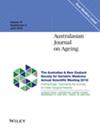The prevalence and related factors of social frailty in older adults: A low- and middle-income country perspective
Abstract
Objectives
There are no studies examining the prevalence of social frailty and associated factors in low- and middle-income countries. This study aimed to assess the prevalence of social frailty and identify the contributing factors among older adults in Türkiye.
Methods
This cross-sectional study included 570 participants aged 65 and older, all outpatients at a geriatric clinic. Data for demographics and co-morbidities were collected. Anthropometric measurements and comprehensive geriatric assessments were conducted. Social frailty was assessed using the 5-item Social Frailty Index (SFI), and physical frailty was evaluated with the Fried Frailty Phenotype. Sarcopenia was diagnosed based on low handgrip strength and reduced calf circumference.
Results
Participants' mean age was 75.2 ± 6.3 years. Social frailty, depression, physical frailty and sarcopenia prevalence were 24%, 25%, 14% and 26%, respectively. Social frailty was reported to be statistically higher in women and those living alone, while significantly lower in married individuals. Depression, physical frailty and sarcopenia were more commonly observed in participants with social frailty (p < .01). Furthermore, participants with heart failure and Parkinson's disease were more socially vulnerable than those with other co-morbid conditions. Multivariate logistic regression analysis revealed that age, physical frailty and depressive mood significantly increased social frailty, whereas being married decreased it even after adjusting for potential confounding factors.
Conclusions
Social frailty was more prevalent than physical frailty among Turkish older adults, reaching 24%. Advanced age, depression, physical frailty and being unmarried were strongly related factors to social frailty.

 求助内容:
求助内容: 应助结果提醒方式:
应助结果提醒方式:


